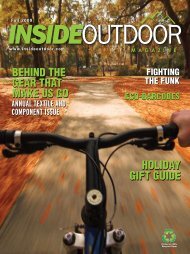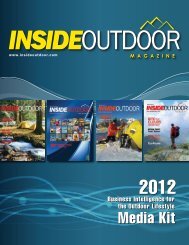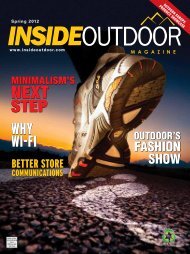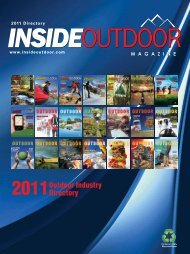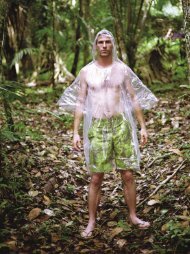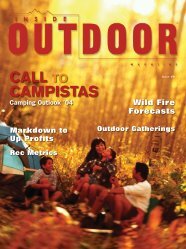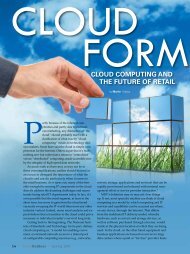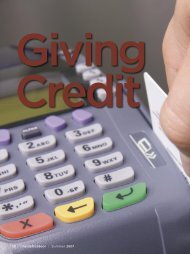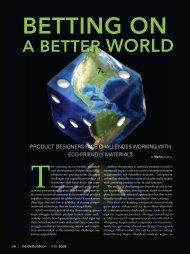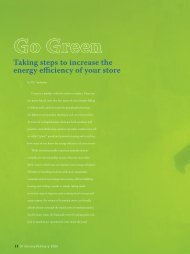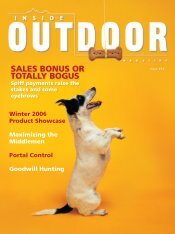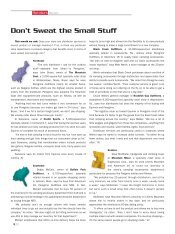Spring - InsideOutdoor Magazine
Spring - InsideOutdoor Magazine
Spring - InsideOutdoor Magazine
Create successful ePaper yourself
Turn your PDF publications into a flip-book with our unique Google optimized e-Paper software.
Greensheets<br />
Carbon Footprint 101<br />
Part II: Preparing for a Life Cycle Assessment<br />
by Ernest Shiwanov<br />
In the last issue of Inside Outdoor (Winter 2008), we<br />
covered the concept of carbon footprint and the tools used<br />
to make that assessment (IO archives can be found at www.<br />
insideoutdoor.com). Part II will cover what you probably will be<br />
looking at in terms of dollars and time for your operation’s life<br />
cycle assessment (LCA).<br />
The good news is technological advances and recent<br />
revisions in process LCAs and Economic Input Output LCAs<br />
(EIO-LCAs) have made the process viable for just about any<br />
level of business. Your LCA professional will guide you through<br />
an evaluation of your business so you will know what level<br />
of assessment would be appropriate. What follows is a brief<br />
refresher on the LCAs and basic information on some of the<br />
companies that are providing this service.<br />
Let us begin by reviewing the three basic methods of<br />
LCAs:<br />
1. For process LCA or bottom-up LCA, ISO (International<br />
Standards Organization) 14040-2006 and 14044-2006 is the<br />
methodology.<br />
2. Economic Input Output LCA (EIO-LCA) or top-down LCA is<br />
based on the work of W. Leontief. It uses a general equilibrium<br />
model that makes a simplified assumption regarding the<br />
output of goods in a commodity sector and its proportional<br />
relationships to other sectors. More and more, EIO-LCA<br />
service providers are incorporating process LCA elements<br />
into their analysis, if appropriate, for their clients.<br />
3. Hybrid LCA, like the car that uses both gasoline and electricity,<br />
runs on process LCA and EIO-LCA methodologies.<br />
Process LCA<br />
Five Winds International director John Heckman says that<br />
Five Winds has done ISO 14040 conforming studies for under<br />
$10,000 and in less than 30 days. He is quick to point out that<br />
Five Winds also has undertaken studies that last several years<br />
at cost commensurate with the commitment. Every business is<br />
unique, so you can assume that your business probably will be<br />
somewhere in between those two sets of circumstances.<br />
As far as the nuts and bolts go, Heckman explains that the<br />
starting point for an ISO 14040 study is the “goal and scope”<br />
definition meeting with the client. He suggests if you want to see<br />
what you need to prepare for an LCA, read ISO 14040 and 14044.<br />
As it turns out, ISO 14040 and 14044 were simplified in 2006 to<br />
make the standard more user friendly, cutting the amount of pages<br />
nearly in half, resulting in ISO 14040-2006 and 14044-2006.<br />
Heckman likens the standards to accounting rules for<br />
mapping “all material and energy flows from cradle to end-oflife.<br />
It’s very analogous to financial accounting, really.”<br />
He goes on to say that the World Resources Institute (WRI)<br />
and the World Business Council for Sustainable Development<br />
(WBCSD) and ISO 14064.1-3 are on the same page in bringing<br />
about carbon dioxide measurements. In fact, a quick check<br />
revealed that ISO, WRI and WBCSD elected to jointly promote<br />
both the ISO standards 14064 and WRI’s and WBCSD’s<br />
GHG Protocol Initiative (GHG = greenhouse gas). Their first<br />
promotional event was held at the UN Climate change meeting<br />
last year in Bali.<br />
On the differences between process LCAs and EIO-<br />
LCAs, Heckman uses an analogy of a magnifying glass and a<br />
microscope, “both being useful tools to a researcher.” However,<br />
if you require the actual environmental impact analysis for the life<br />
cycle of materials and their energy flow, and have the money to<br />
do a complete study, process LCA is the most appropriate tool.<br />
“There is no substitute for actual data,” he says.<br />
Conscious Brands’ experience, meanwhile, lies in the organic<br />
food and beverage industry. Guayaki (yerba matte tea, etc.) and<br />
Manitoba Harvest are just two of Conscious Brands’ clients.<br />
Rob Sinclair and Oliver Ferrari are the principle consultants that<br />
have partnered with Greenhouse Gas Protocol (GHG Protocol<br />
Initiative, see above), Zerofootprint and ISO 14040 in bringing<br />
carbon mitigation strategies to their clients. A typical study will<br />
take at least six months and cost around $10,000.<br />
However, it is worth mentioning that both Sinclair and<br />
Ferrari are on steering committees involved in the Carbon<br />
Trust-sponsored British Standards Institution Publicly Available<br />
Specification 2050 or BSI PAS 2050 standard.<br />
According to the Carbon Trust Web site, “The PAS aims<br />
to bridge the gap between the existing detailed (process<br />
LCAs) and more general approaches (EIO-LCAs) and provide a<br />
standardised, consistent method organisations can practically<br />
use for measuring the GHG emissions embodied in products<br />
and services.” The PAS 2050 standard has an egalitarian “for<br />
the people, by the people” foundation, as Sinclair explains. It<br />
was developed with the help of many businesses, industries<br />
and thousands of individuals.<br />
Despite this emerging hybrid LCA standard, Sinclair and<br />
Ferrari feel there is a disconnect between the organic foods<br />
consumers buy and the way carbon numbers relate to them.<br />
For that reason, during the next six to 12 months, they will<br />
be working on a method for taking the numbers derived from<br />
the various assessment tools to the “next step.” That is a way<br />
for consumers to get their hands around the meaning of GHG<br />
mitigation. This effort will be represented in a scheme called<br />
www.carbonlabels.org, a joint project by Conscious Brand’s<br />
Sinclair and Ferrari and Zerofootprint. This initiative goes beyond<br />
42 | <strong>InsideOutdoor</strong> | <strong>Spring</strong> 2008



